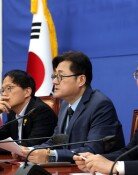U.S. strategic assets sent to Korean Peninsula
U.S. strategic assets sent to Korean Peninsula
Posted February. 03, 2023 07:48,
Updated February. 03, 2023 07:48
The United States dispatched its strategic long-range bomber Rockwell B-1 Lancer and fighter jets such as the F-22 and the F-35B on the Korean peninsula on Wednesday. These U.S. strategic assets flew over the West Sea along with South Korea's F-35A as part of the two allies’ first joint aviation drill since this year. They came the next day after U.S. Defense Secretary Lloyd J. Austin III said in a meeting with his South Korean counterpart that the U.S. government will more frequently deploy the F-22, the F35, and aircraft carriers on the Korean peninsula. On Thursday, the North Korean regime resentfully commented “nuke for nuke and confrontation for confrontation” to signal responses of the strongest stringency in case of any military attempt to be made by Washington.
The dispatch of the U.S. strategic assets is thought of as Washington's move to make sure that it never leaves unfulfilled. The promise that extended deterrence will be provided in response to North Korea's nuclear and missile provocations. It is a rarity that the top three U.S. strategic aviation assets are deployed in one go. Added to this, the U.S. military carried out the drill right over the West Sea, one of the most sensitive areas for China, which takes sides with North Korea, to apply pressure on Beijing. It is interpreted that Washington clearly showed strong determination and capabilities just as Secretary Austin stressed that U.S. pledges are not merely loaded with slogans but are driven by firmness and stringency.
This measure is a strong warning message for North Korea and carries a meaning for South Korean citizens. Despite the United States’ repeated defense pledges made in response to the ever-advancing nuclear threats, there has been a question raised among the South Korean public that the country may not be provided with any prevention by its ally as even the U.S. mainland is under threat. Some even argue that Seoul should independently opt for nuclear armament. In a sense, Washington set up this all-out joint aviation exercise to quell such public concerns and show strong determination to keep its words.
However, regrettably, it is seen that the B-1B Lancer, nicknamed the “Swan of Death,” which is known as one of the biggest threats to Pyongyang, has been sent to the Korean peninsula only for show. It has been three months since the B-1B was dispatched last November. Coincidentally, it was sent right after the two allies’ defense ministers met at last year's Security Consultative Meeting (SCM) in Washington. Some even presume that Washington might have taken the defense ministerial meetings as an opportunity to ask Seoul to make greater contributions to global security going beyond North Korean nuclear issues; and deployed the B1-B in return.
Seoul and Washington last year agreed upon the “timely, coordinated” deployment of US strategic weapons, which serves as the axis for extended deterrence. Starting from a deterrence strategy committee table-top exercise (DSC TTX) scheduled this month; they should increase practical capabilities based on joint plans and drills for peacetime deployment and control. Indeed, the way to deter North Korean provocations and reassure South Korean citizens is how actively the allies demonstrate deterrence capabilities promptly.







